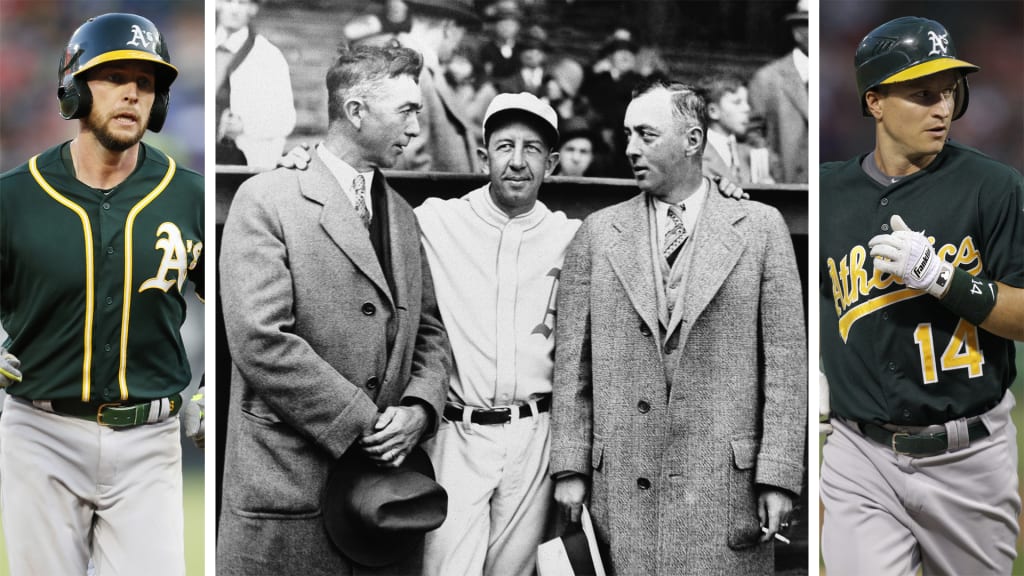
No one loves a good debate quite like baseball fans, and with that in mind, we asked each of our beat reporters to rank the top five players by position in the history of their franchise, based on each player’s career while with that club. These rankings are for fun and debate purposes only. If you don’t agree with the order, vote in the Twitter poll for your favorite at this position.
Here is MLB.com’s ranking of the top five second basemen in A’s history, as selected by Martín Gallegos. Next week: third basemen.
1) Eddie Collins, 1906-14, '27-30
Key fact: 55.9 fWAR is third highest in franchise history among position players (first among second basemen)
Collins was one of baseball’s original speedsters, swiping bases at a rate the American League had never seen before. He became the first player in AL history to steal 80-plus bases with 81 in 1910 and demonstrated plenty of swiftness with at least 55 stolen bases in five of six seasons from 1909-14. He remains the only player in Major League history to steal six bases in a game twice.
But don’t think Collins was just another guy who could solely run fast. The second baseman was an elite hitter who mastered the art of small ball, now owning the all-time record for sacrifice hits with 512 over his career. He never batted lower than .324 from 1909-14 and got on base plenty, leading the league in runs scored for three consecutive seasons ('12-14). On a team filled with stars, it was hard enough to stand out in the famed "$100,000 Infield" that also included Stuffy McInnis at first, Jack Barry at short and Frank “Home Run” Baker at third, yet Collins did just that in 1914 by capturing the AL MVP Award.
A key piece of the original A’s dynasty that won back-to-back World Series titles from 1910-11 and another in '13, Collins was sold to the White Sox before the '15 season. He continued to be a star in Chicago, where he played for 12 seasons and in 1925 became the sixth player in baseball history to reach 3,000 hits.
With his status as one of baseball’s legends secured, Collins reunited with his original club for the final four seasons of his career as a player-coach, seeing limited time on the field. His .337 career batting average with the A’s remains the third highest in club history and highest among second basemen. Collins was inducted into the Baseball Hall of Fame in 1939.
2) Max Bishop, 1924-33
Key fact: 1,043 walks are second most in club history
Long before the A’s popularized the "Moneyball" approach that prioritized getting on base, Bishop was showing the league just how valuable plate discipline can be. He drew at least 100 walks in eight straight seasons (1926-33) and led the league with 128 free passes in '29. Bishop served as the table-setter at the top of the lineup for sluggers like Jimmie Foxx and Al Simmons in the midst of an A’s dynasty run that saw them capture back-to-back World Series titles from 1929-30 and another AL pennant in '31.
It’s easy to understand why Bishop earned the nickname “Camera Eye” from his peers. His career walk rate of 20 percent is the third highest in Major League history, behind only Ted Williams’ 20.6 percent mark and Barry Bonds' 20.3 percent clip. His 1,043 walks with the A’s served as the most in club history until another legend by the name of Rickey Henderson came around.
3) Mark Ellis, 2002-11
Key fact: .990 fielding percentage is highest among 2Bs in club history
Ellis may not have been the flashiest defender. That, combined with a quiet personality, may have caused him to be overlooked at times when it came to voting for the Gold Glove Award. But make no mistake: He was a rock for the A’s, providing stability at second base for a decade.
The sure-handed Ellis twice led Major League second basemen in fielding percentage, including a .997 mark in 2006 that was a single-season record at the time. He also set a franchise record for second basemen with a 102-game errorless streak in '07 from May 14 to Sept. 10. Ellis wasn’t just all glove, either. He developed into a solid contributor on offense, leading the A’s in batting average in 2005 (.316) and 2010 (.291) and finishing tied as the club’s all-time leader for home runs by a second baseman with 86. He’s also the last A’s player to hit for the cycle, achieving the feat June 4 against the Red Sox in '07.
A regular for the A’s in their playoff runs of the early 2000s, Ellis appeared in 12 postseason games with the club, batting .256/.347/.372. He was traded to the Rockies in 2011, but his nine seasons with the A’s (he missed all of 2004 with a shoulder injury) made him adored, made evident when he was voted by fans as being one of the 50 greatest Oakland A’s as part of the club’s 50th anniversary of playing in Oakland in 2017.
4) Dick Green, 1963-74
Key fact: Earned Babe Ruth Award in 1974 World Series
Not many players get the chance to go out on top like Green did, retiring in 1974 after the A’s won their third consecutive World Series. Despite not registering a hit in the '74 Fall Classic, Green managed to earn the Babe Ruth Award on the strengths of a defensive performance that featured six double plays in a five-game series. He started game-ending double plays in Games 3 and 4 of that series against the Dodgers.
He wasn’t quite as talented with the bat as others on this list, but Green did have some pop: His 80 career home runs the third most by a second baseman in franchise history.
5) Jed Lowrie, 2013-14, '16-18
Key fact: One of just two A's second basemen to make an All-Star team
There are two versions of Lowrie with the A’s. The first stint came mostly as a shortstop after he was acquired in a February 2013 trade with the Astros. Lowrie returned to the A’s in November '15, again in a trade with the Astros, and embarked on a career renaissance of sorts.
Lowrie immediately moved to second base in his second stint after the club traded for Marcus Semien, and he evolved into a hitting machine. His 49 doubles in 2017 set a single-season Oakland record, just four shy of Al Simmons’ franchise record. As good as that year was, 2018 Lowrie was even better. He established himself as a key piece in the middle of the order, earning the first All-Star selection of his career at age 34 in a campaign that saw him garner a few votes for AL MVP thanks to a .267/.353/.448 slash line with 23 home runs, 37 doubles and 99 RBIs.
Honorable mentions
• Tony Phillips spent the first eight seasons of his career with the A’s and returned to Oakland for his final season in 1999. He forever has a special place in A’s lore after making the throw to Dennis Eckersley for the final out of the club’s last World Series championship in '89.
• Mike Gallego’s aggressive play on defense made him a fan favorite of the A’s playoff teams of the late 1980s. He returned to the organization as the A’s third-base coach from 2009-15.
• Phil Garner spent the first four seasons of his career with the A’s and became the club’s first All-Star second baseman in 1976.


